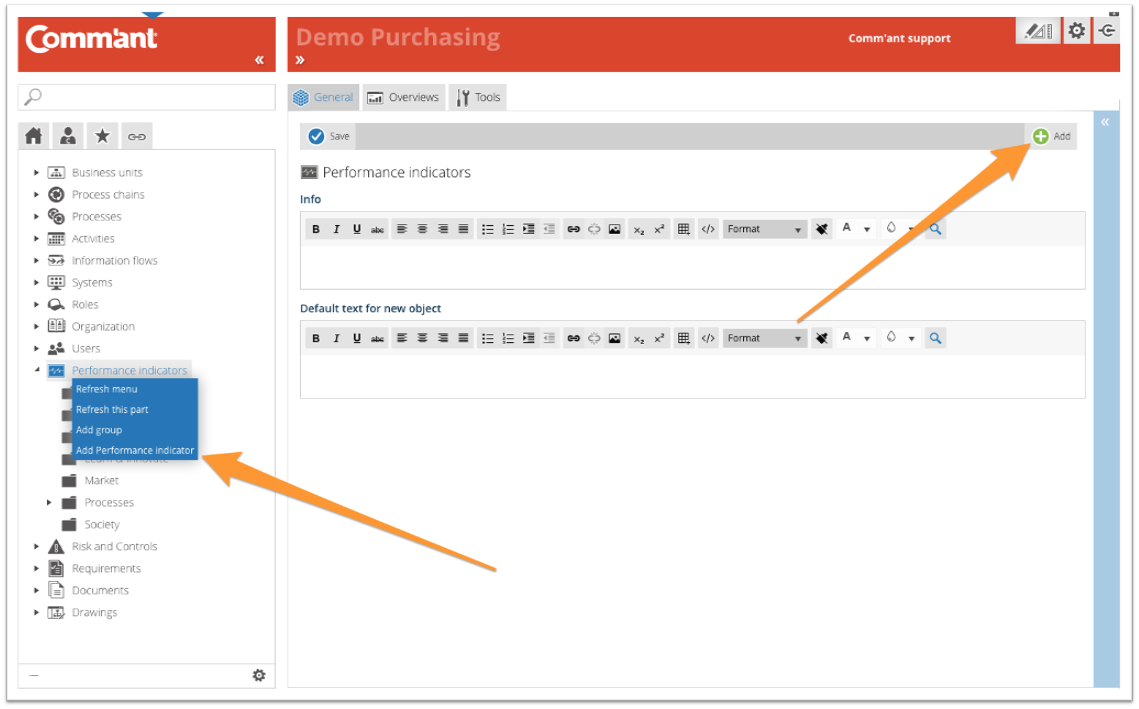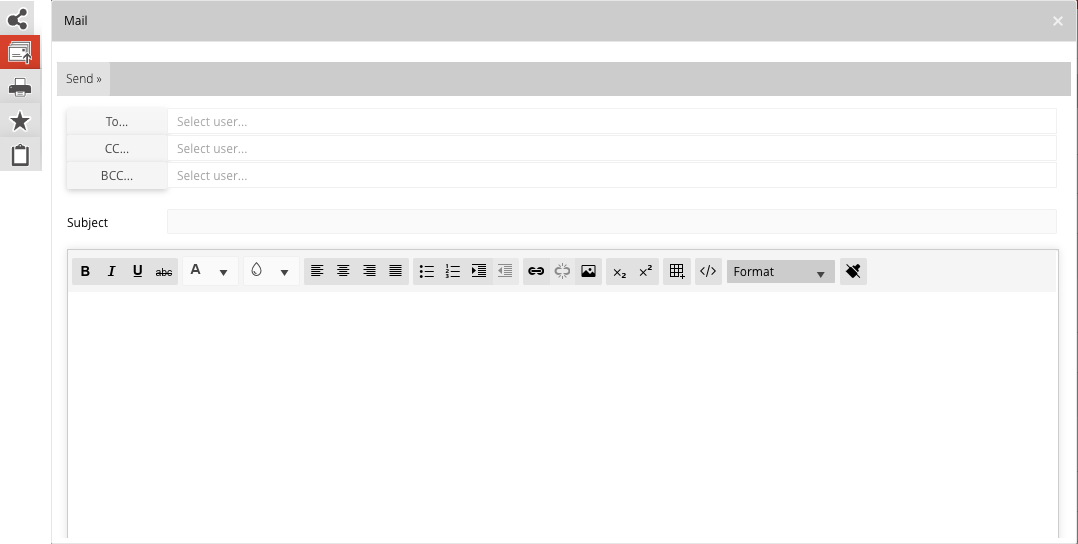Capture Performance indicators
The various Performance indicators are added via the Navigation menu. It is possible that you do not immediately see the Performance indicators in the Navigation menu (this depends on the settings in your system), you can make them visible via the button at the bottom left ![]() .
.
Performance indicators can measure many different aspects of a Process, for example, logistics, cost, risk, and quality. Depending on the type and metrics, it can measure things like:
- Logistics, information about: quantity, time, place
- Cost, information about: capacity, budget, expenses
- Risk, information about: probability, the time between event, (financial) impact
- Quality, information about: meeting approved criteria
Comm’ant’s emphasis is on the clear definition of the Performance indicator and its relationship to process, information and people. Other tools are used to collect data and compile it into information, mainly numerical reports and graphical displays of information. If your management system is equipped with the optional Comm’ant Forms, you can also use them to record and report on Performance indicators.
This type of reporting can be linked to the Performance indicator in Comm’ant with shortcuts.
To create Performance indicators, make sure you are in Develop mode via the switch ![]() in the Application bar (right behind your Username).
in the Application bar (right behind your Username).
Create new Performance indicators:
Step 1
Select Performance indicators in the Navigation menu, right-click and select “Add Performance indicator” or click “Add” in the top right corner of the Main screen.
Create Performance indicators with at least the name by entering it in the “name Performance indicator” field. The name can be changed later on. Give the Performance indicator a clear and unique name.
Performance indicators are always used to measure and report something, so make sure the component and subject of the Performance indicator are made clear in the name.
Examples:
- Number of complaints
- Hours lost due to defect
- The order to invoice
- Indexing customer satisfaction
- The percentage of market share
Step 2
Add more information and save when you are done using the Save button at the top left:
- Fill in the Description Describe the content. If you want to go into details, decide whether these details should be clarified here or at a lower level. Extended descriptions can also be added as a document. You can refer to the document in the Description.
A useful definition of Performance indicator provides answers to:- Why are we measuring?
- What do we measure?
- How (source, formula) do we measure?
- What are the limits to an accepted value (high, low, etc.)?
- What to do when we under or over-perform (constructed scenarios on how to respond to such situations)? etc.
- Add Remarks. Write specific comments here, especially during development and changes to the system. When you use special characters, such as @@ in combination with your initials and followed by a comment, you can easily find your comments with the search function, follow up and complete the work.
- The Sort index allows you to influence the order in which Comm’ant sorts the objects. If nothing is entered here, the objects are sorted in alphanumeric order. Using the Sort index changes the order. The order will then be sorted according to the Sort Index, again in alphanumeric order. The objects that have no value in the Sort Index field will be sorted in alphanumeric order, at the end of the total list.
- With Valid until you indicate when the content of the object must be reviewed. Comm’ant automatically assigns the current date plus one year to this field. This date can be changed if the period of validity ends on another date. Passing the date will not change the display. An overview of the objects whose date is about to expire or have expired can easily be created via a report.
- The Validated checkbox ensures that the newly created object is validated. If this box is not checked, the object will keep the encoding “Not validated” in the system. The advantage of this is that you can make an extra check on your recent additions in Comm’ant. You can generate an overview based on the status “Not validated” to show all changes and then go through them again, reviewing them for consistency and correctness before validating them. Validate the object by ticking the checkbox.
- The Revision field automatically shows the save date and time.
Step 3
After saving, you also have the option to complete the Performance indicators with connections to other objects: Roles, Documents, Process chains, Processes, Activities, Information flows and Groups.
These can be existing or new objects. Existing objects are displayed in the connect boxes. You can create new objects right here via the plus sign at the top edge of the connect box. It is possible to disconnect existing links using the red unlink icon.
- Connect the Roles and Organization objects that have been formalized for this Performance indicator. It is common here to connect a position with the Role of Owner or Controller of the Performance indicator. To see which Users are connected to those positions use the “Connections” button at the top of the Navigation Menu. Here it is also shown whether this User has modification rights.
- When you connect the Performance indicators to Documents, you add connections to files or shortcuts. Select an existing document or create an object for a new one.
- When you connect the Performance indicators to a Group, it will be displayed in the Navigation menu in the folder of this Group, or you will find the Performance indicators in the folder “Not classified”.
Note: The changes in the text and date fields are saved via the Save button, other changes such as creating or deleting links are immediately updated; it is not necessary to save them explicitly.
To change a Performance indicator:
To be able to modify a Performance indicator, make sure you are working in Develop Mode via the switch in the Application Bar.
When you select a Performance indicator in the Navigation menu with the left mouse button, you immediately have the possibility to change it.
You can save the changes via the “Save” button.
To delete a Performance indicator:
When you delete a Performance indicator, all links it has had to Process chains, Processes, Information flows, Roles, Organizations, and Documents/Links will be deleted. The other sub-objects, such as Roles, Organization, and Documents, remain in the system.
A Performance indicator can be deleted by clicking on “Delete”. You will first receive a confirmation request before the Performance indicator disappears. Deleting is irreversible.
Inform the Users:
When you make significant changes, you may notify affected Users. You can do this efficiently via e-mail via the Mail button in the top right corner of “Share”.
When changing one Performance indicator, you may decide to inform all Users associated with the information flow, so also where the Performance indicator is attached.




